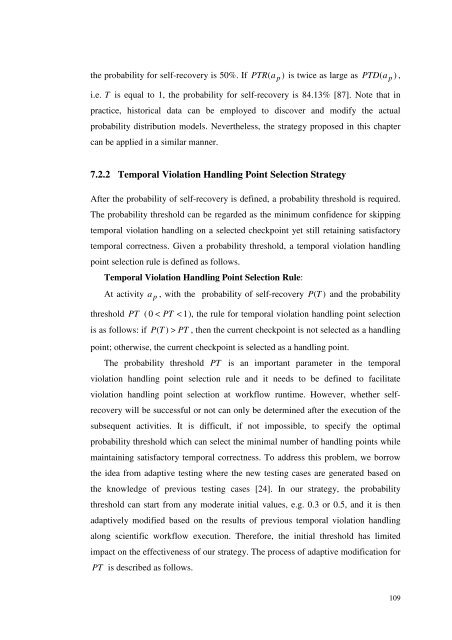Xiao Liu PhD Thesis.pdf - Faculty of Information and Communication ...
Xiao Liu PhD Thesis.pdf - Faculty of Information and Communication ...
Xiao Liu PhD Thesis.pdf - Faculty of Information and Communication ...
Create successful ePaper yourself
Turn your PDF publications into a flip-book with our unique Google optimized e-Paper software.
the probability for self-recovery is 50%. If PTR ( a p ) is twice as large as PTD ( a p ) ,<br />
i.e. T is equal to 1, the probability for self-recovery is 84.13% [87]. Note that in<br />
practice, historical data can be employed to discover <strong>and</strong> modify the actual<br />
probability distribution models. Nevertheless, the strategy proposed in this chapter<br />
can be applied in a similar manner.<br />
7.2.2 Temporal Violation H<strong>and</strong>ling Point Selection Strategy<br />
After the probability <strong>of</strong> self-recovery is defined, a probability threshold is required.<br />
The probability threshold can be regarded as the minimum confidence for skipping<br />
temporal violation h<strong>and</strong>ling on a selected checkpoint yet still retaining satisfactory<br />
temporal correctness. Given a probability threshold, a temporal violation h<strong>and</strong>ling<br />
point selection rule is defined as follows.<br />
Temporal Violation H<strong>and</strong>ling Point Selection Rule:<br />
At activity<br />
a p , with the probability <strong>of</strong> self-recovery P (T ) <strong>and</strong> the probability<br />
threshold PT ( 0 < PT < 1), the rule for temporal violation h<strong>and</strong>ling point selection<br />
is as follows: if<br />
P ( T ) > PT , then the current checkpoint is not selected as a h<strong>and</strong>ling<br />
point; otherwise, the current checkpoint is selected as a h<strong>and</strong>ling point.<br />
The probability threshold PT is an important parameter in the temporal<br />
violation h<strong>and</strong>ling point selection rule <strong>and</strong> it needs to be defined to facilitate<br />
violation h<strong>and</strong>ling point selection at workflow runtime. However, whether selfrecovery<br />
will be successful or not can only be determined after the execution <strong>of</strong> the<br />
subsequent activities. It is difficult, if not impossible, to specify the optimal<br />
probability threshold which can select the minimal number <strong>of</strong> h<strong>and</strong>ling points while<br />
maintaining satisfactory temporal correctness. To address this problem, we borrow<br />
the idea from adaptive testing where the new testing cases are generated based on<br />
the knowledge <strong>of</strong> previous testing cases [24]. In our strategy, the probability<br />
threshold can start from any moderate initial values, e.g. 0.3 or 0.5, <strong>and</strong> it is then<br />
adaptively modified based on the results <strong>of</strong> previous temporal violation h<strong>and</strong>ling<br />
along scientific workflow execution. Therefore, the initial threshold has limited<br />
impact on the effectiveness <strong>of</strong> our strategy. The process <strong>of</strong> adaptive modification for<br />
PT is described as follows.<br />
109
















